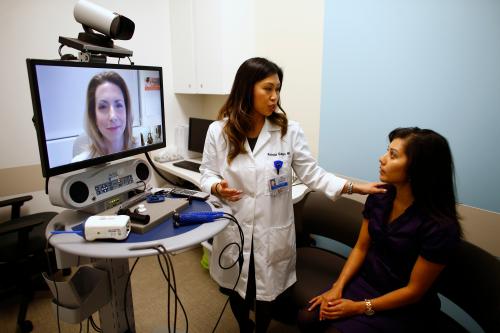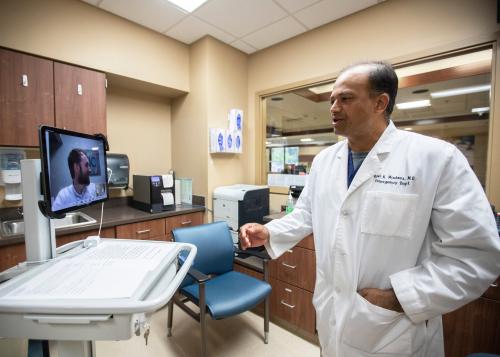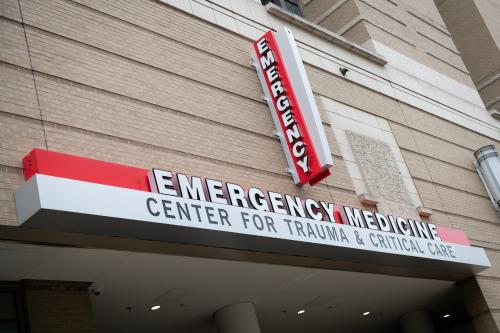The coronavirus outbreak, or COVID-19, has fundamentally transformed our lives and communities, contributing to economic declines, disruptions in schooling, and distressed hospital systems. However, the pandemic has generated some silver linings, including the widespread adoption of telehealth that has helped to mitigate the risk of community spread by reducing unnecessary hospital visits and ensuring real-time access to medical providers for millions of Americans. According to a report by McKinsey, in the aftermath of COVID-19 epidemic, medical providers have rapidly scaled their telehealth offerings and are seeing 50 to 175 times the number of patients via remote access platforms than they did before. Some patients have even come to prefer virtual office visits as medical providers have been less resistant to the change and even more willing to administer remote care from an internet-enabled device.
Last month, the Trump administration lauded their efforts to relax the legislative and regulatory restrictions limiting the use and adoption of remote medical care. And rightfully so. Early reports indicate various benefits from cost reduction in both medical and mental services to quality improvement, as well as increased patient satisfaction. But given the ravaging effects of the pandemic on U.S. citizens and the focus on health care leading up to the national election, will telehealth still be available, or potentially be made permanent, as an option for patients in need of immediate, primary, or secondary care? Will previous regulatory guardrails be reinstated on emerging models of health care delivery, potentially suppressing the number of providers and patients accessing such resources?
To start, certain conditions must be instituted to ensure long-term delivery of telehealth services, starting with access to high-speed broadband among patients and providers, national interoperability, new fraud detection methods, and more lenient and favorable federal and state policies towards its use. Further, as people of color, especially African Americans, become disproportionately impacted by COVID-19 in both infections and deaths, the adoption of telehealth practices to address and potentially reduce the immediate and long-term delivery of care will be important. Across the U.S., African Americans are dying at a rate of 88.4 deaths per 100,000 population, more than twice the rate of white Americans (40.4 deaths per 100,000 population).
Broadband networks (especially 5G) will be critical to telehealth delivery
The Federal Communications Commission (FCC) has reported that more than 18 million Americans do not have access to high-speed broadband networks. This lack of access to digital connectivity has far-reaching impacts on more vulnerable populations, including those with medical conditions or those who live in areas with limited access to quality health care facilities. Having access to broadband is a prerequisite in telehealth’s use. Patients require access to reliable internet connections that support high-speed transmissions to use remote health care services and attend virtual office visits.
Unfortunately, COVID-19 has revealed the relationship between poverty, geography, education and a host of other variables on one’s access to broadband in the U.S. For rural populations, access to health care is constrained by the lack of local quality services and infrastructure, doctor workforce shortages, fewer dollars, and cybersecurity vulnerabilities. Low-income, urban populations experience similar problems, making the emergency room their first point of contact for service.
Given the historical effects of being “socially distanced” from medical care, telehealth can mitigate health care access, costs, and even remediate certain chronic diseases of vulnerable groups, including seniors, who were more likely to be both impacted and isolated by COVID-19. During the pandemic, Congress appropriated $200 million in funding as part of the Coronavirus Aid, Relief, and Economic Security (CARES) Act to support the ability of health care providers to offer connected care. The COVID-19 Telehealth Program enabled reimbursements to the providers and last month, several lawmakers requested details on its progress and called for its continuation. But expanding the eligibility and payment of telehealth services are just parts of the larger problem of a widespread digital divide that forecloses on its use by vulnerable populations.
One specific area of broadband expansion that will be critically important to telehealth delivery will be the availability of 5G, which can enable mobile phones as the prime point of contact for providers and patients. Smart phones are now much more common and ubiquitous than personal computers and laptops. The type of latency and resiliency embedded in 5G networks can accelerate more reliable virtual connections as well.
Further, a virtual doctor visit is a very private exchange, which is a concern expressed by a large majority of Americans. While a PC is limited in portability and often shared by multiple members in a household, a smart phone typically has a single user, and allows for encrypted communications that enable a higher level of patient privacy over digital connections. In addition to incentivizing and reimbursing providers for telehealth use, it is imperative that next-generation mobile broadband networks be affordable and available in both rural and urban communities to accelerate adoption.
Support nationwide interoperability
Physicians should be able to share medical information between themselves and their patients in order to enhance the quality of medical services and avoid redundancies. National efforts to enable interoperability between different healthcare providers have not been successful. Particularly, lack of interoperability between different electronic systems across the healthcare delivery system is one reason for delay in reporting of the COVID-19 test results. To enhance the quality of virtual visits, physicians need to have access to their patients’ medical data including medications, labs (such as COVID-19 testing), hospitalizations, and imaging data. For example, New York City’s Health Information Exchange (HIE) platform made it possible to merge the patients’ COVID-19 testing data with their prior medical data. This enables a much better understanding of patients’ clinical conditions and more importantly, allows providers to identify high-risk populations and prioritize them in their prevention efforts.
Despite their importance, interoperability efforts have not been successful in many parts of the U.S. This is in spite of the more than a decade of nationwide efforts, trying many different approaches to interoperability and billions of dollars of incentives and grants. While there are still some technical barriers to exchange of health information, the most important impediment to interoperability continues to be economic disincentives for providers to share data. COVID-19 has led to fundamental changes in expectations of patients, providers and payers about data exchange. Given the circumstances, patients are much more willing to receive their test results through online patient portals. It is now in the best interest of providers to willingly share clinical data with public health officials and other providers as part of a community effort to fight the epidemic.
The Department of Health and Human Services (HHS) has just provided effective guidelines to overcome the technical barriers to health information exchange and more importantly, has set specific rules to identify information blocking and sever penalties for violators. These significant economic, legal and technical changes have created the most favorable ecosystem for health information exchange platforms to emerge and expand. Healthcare organizations and IT vendors should take advantage of this environment to streamline their data exchange processes. Otherwise, demand and enthusiasm for telehealth services will wither as the epidemic gets under control and we go back to normalcy.
Institute new fraud detection methods
While telemedicine facilitates legitimate medical services, it can also make it easier for fraudsters to abuse the system. In one commonly-used scheme, fraudsters recruit Medicare patients to visit physicians for unnecessary reasons and get prescribed expensive medical devices which Medicare will ultimately pay for. In a recent incident, DOJ charged a network of telehealth companies, physicians, and patient recruiters in a $1.2 billion Medicare fraud scheme. Given that telehealth is a new medium for delivering health care, the areas of more susceptible to fraud may be unique and unknown to the federal agencies, making it more difficult to detect and stop.
DOJ and HHS may consider collaborations on new models or systems that proactively monitor, and audit unusual billing behaviors related to telehealth services. Considering that the pandemic suddenly increased patient demand for remote care, new fraud detection methods may also improve upon data collection, service coding, and move away from reimbursements based on parity laws to maintain the high quality of services.
Continue lenient rule making and favorable policies
The Centers for Medicare and Medicaid Services (CMS) has been extremely proactive to implement a wide variety of policies to expand telehealth services during the COVID-19 epidemic. These policies include waiving limitations on the types of clinical practitioners that can furnish Medicare telehealth services, allowing hospitals to bill for telehealth services to Medicare patients registered as hospital outpatients even when the patient is at home, increasing the payments for telephone visits to match those of in-person office visits, and expanding payments for telehealth services to rural health clinics and federally qualified health clinics. While these policies were implemented as emergency measures in response to COVID-19 epidemic, more than 5.8 CMS beneficiaries took advantage of remote office visits, especially in the areas of mental health.
While it has taken decades for Congress and state regulators to operationalize limited remote health care, it took just weeks to implement such changes nationwide. Bipartisan lawmakers are currently pushing for the permanence of telehealth options post-pandemic in a letter that continues to receive more signatures. Despite the last few months of provability in cost savings and care remediation, the fate of telehealth is still undetermined, especially in an election year where health care is often a partisan issue.
Leverage telehealth to address health disparities
Finally, the challenges of being stricken by multiple health factors that impact is all too familiar among vulnerable populations. Lack of access to doctors, insurance, nutritious food, and safe workspaces, among other areas can all contribute to the persistent and growing health disparities impacting people of color, especially African Americans and Native Americans. These heightened risk factors for people of color can trigger a host of chronic ailments, including diabetes, pulmonary failures and disruptions, cancer, and other rare conditions. In cities where Black people comprised the majority of the population, COVID-19 related illnesses and deaths have been disproportionately high and correlated with such underlying medical conditions.
For all the reasons previously stated in a May 2020 Brookings report, telehealth can improve upon the health inequities that have debilitated communities of color through real-time delivery and availability of care, provided that broadband access and lenient CMS policies were still made available to these populations. Vulnerable populations would also benefit from the institution of new and improved fraud detection monitors to avoid the deceptive practices of bad actors in the medical community who prey upon people of color, the elderly, and their frail conditions.
In the end, measures to reduce the spread of COVID-19 have accelerated the availability and adoption of remote health care services. However, as the last six months have largely represented a national pilot to creatively redress the challenges of social contact, the federal government and the next administration must determine whether telehealth can continue to play a competitive and complementary role in health care. The regulatory conditions, the incentives for doctors, and the political will of the country to remedy health disparities and care fragmentations will largely determine if telehealth becomes permanent.










Commentary
How to make telehealth more permanent after COVID-19
September 4, 2020